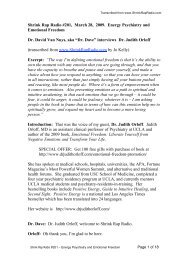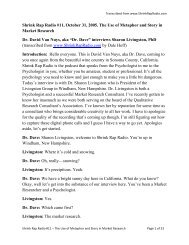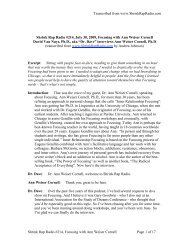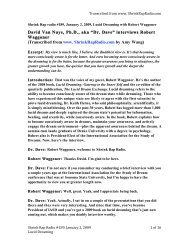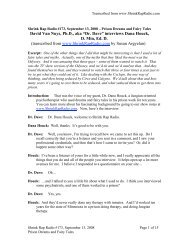interviews John Beebe, MD - Shrink Rap Radio
interviews John Beebe, MD - Shrink Rap Radio
interviews John Beebe, MD - Shrink Rap Radio
You also want an ePaper? Increase the reach of your titles
YUMPU automatically turns print PDFs into web optimized ePapers that Google loves.
Transcribed from www.<strong>Shrink</strong><strong>Rap</strong><strong>Radio</strong>.com<br />
the audience just ahead of us. And he’s watching her. And then gradually,<br />
gradually, the camera turns and we see the face of the man watching her. And it’s<br />
Cary Grant. And then Cary Grant begins to interrogate Ingrid Bergman and to<br />
make critical and somewhat sarcastic remarks about her, but also check her out to<br />
see if he can recruit her for a spy mission to look into the Nazis her father was<br />
associated with because he has determined that she actually was not on her father’s<br />
side. He being the man who was tried in that scene we saw first. So suddenly, our<br />
critical watching of this woman becomes a character who then begins to interact<br />
with her. Now, that’s something very different from either a film or a fairy tale.<br />
It’s a sensibility engaging with the material. And that’s the secret of the auteur<br />
theory, and it’s also the secret of how film works. Film works by having the<br />
consciousness of someone interact with the unconscious presentations of the<br />
characters so that something very odd happens – a kind of dialogue takes place<br />
between conscious and unconscious. And that’s what Jung means by active<br />
imagination as opposed to passive imagination. Now, to be fair, half the films that<br />
are released are simply passive imagination, of wishful fantasies – what it might be<br />
like to go on a date, or get married, or have an adventure. And there’s no dialogue;<br />
there’s just a standard presentation of a scenario. So it might just be an updated<br />
fairy tale or a dream. But when you introduce that element of a consciousness,<br />
dialoguing and the meaning of the story keeps changing as the consciousness<br />
engages with it, then I think you have active imagination and you have this auteur<br />
cinema, and you have this cinema being used as a kind of psychological<br />
exploration.<br />
Dr. Dave: You know, I was intrigued by your observation that film has grown up<br />
concurrently with psychoanalysis, nurtured on a common zeitgeist and sharing a<br />
drive to explore and realize the psyche. And I hadn’t thought of that before, that<br />
they kind of, they overlap.<br />
<strong>Beebe</strong>: Right<br />
Dr. Dave: They grew up together, as you say.<br />
<strong>Beebe</strong>: I think Freud’s basic first papers on hysteria and the Lumière brothers' first<br />
demonstration in Paris of cinema and the theater, virtually the same. Virtually the<br />
same.<br />
Dr. Dave: And you note Lumière. The word “lumière” suggests light.<br />
<strong>Beebe</strong>: Light. It’s amazing. It’s amazing how synchronistic names are. You know, the<br />
idea of synchronicity is pretty famous now, the meaningful coincidence…<br />
Dr. Dave: Yes.<br />
<strong>Beebe</strong>: I’ve always thought the great teacher on dreams is Dr. William Dement.<br />
Dr. Dave: (laughs) Yeah, right!<br />
<strong>Shrink</strong> <strong>Rap</strong> <strong>Radio</strong> #166, August 1, 2008 Page 10 of 18<br />
A Jungian View of the Feminine in Film



